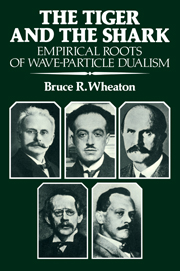Book contents
- Frontmatter
- Contents
- Foreword by Thomas S. Kuhn
- Preface
- Notes on sources
- 1 Introduction
- Part I The introduction of temporal discontinuity, 1896–1905
- Part II Ionization and the recognition of paradox, 1906–1910
- Part III Seeking an electrodynamic solution, 1907–1912
- 6 Localized energy in spreading impulses
- 7 Problems with visible light
- Part IV Interference of x-rays and the corroboration of paradox, 1912–1922
- Part V The conceptual origins of wave–particle dualism, 1921–1925
- Epilogue: The tiger and the shark
- Bibliography
- Index
6 - Localized energy in spreading impulses
Published online by Cambridge University Press: 04 August 2010
- Frontmatter
- Contents
- Foreword by Thomas S. Kuhn
- Preface
- Notes on sources
- 1 Introduction
- Part I The introduction of temporal discontinuity, 1896–1905
- Part II Ionization and the recognition of paradox, 1906–1910
- Part III Seeking an electrodynamic solution, 1907–1912
- 6 Localized energy in spreading impulses
- 7 Problems with visible light
- Part IV Interference of x-rays and the corroboration of paradox, 1912–1922
- Part V The conceptual origins of wave–particle dualism, 1921–1925
- Epilogue: The tiger and the shark
- Bibliography
- Index
Summary
On the basis of … pure undulatory theory, one is led … to consequences that approximate the Newtonian emission theory.
The discussions between Bragg and Barkla in Britain, and between Stark and Sommerfeld in Germany, encouraged attempts to determine how much spatial concentration of radiant energy was demanded by ionization, and how much was compatible with classical electromagnetic theory. Mirroring the different perceptions of and approach to the problems of x-ray absorption in Britain and in Germany, there were two parallel responses. J. J. Thomson recognized that the paradoxes applied equally to all forms of radiation. He influenced important experimental tests of energy localization, and concluded that the classical ideal of symmetry of the electric field around an electron would have to be abandoned. Arnold Sommerfeld took no refuge in the alteration of the physical interpretation of Maxwell's theory. He pressed formal electrodynamics to its extreme to show that the energy of y-rays might be localized to an extent compatible with recent experiments.
But neither Thomson's nor Sommerfeld's treatment addressed the most compelling problem raised by Bragg and Stark. The energy transferred from a wave to an electron does not seem to change when the distance from the source changes. No matter how severely limited in angular extent the energy of x-rays and γ-rays might be according to Thomson or Sommerfeld, that energy is still diluted in strength as the rays traverse space. Neither of them therefore confronted the issues in quite the same way as did Bragg, who had never intended his neutral-pair hypothesis to apply to ordinary light.
- Type
- Chapter
- Information
- The Tiger and the SharkEmpirical Roots of Wave-Particle Dualism, pp. 135 - 167Publisher: Cambridge University PressPrint publication year: 1983



